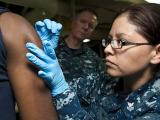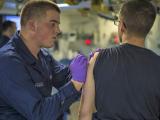Nov 6, 2003 (CIDRAP News) A team of researchers in St. Louis has retooled a mousepox virus so it can defeat a vaccine that normally protects micebut has also found ways to beat the customized virus, according to the group's leader.
Mark Buller, PhD, a virologist at St. Louis University, says his group has built on the work of Australian researchers, who reported in 2001 that they had accidentally engineered a mousepox virus that was lethal to vaccinated mice. Buller's group modified the mousepox virus in a similar way but also developed two treatment combinations that protected mice from the altered virus.
Buller described the studies recently at an international conference in Geneva on the threat of smallpox. His talk sparked a discussion at the meeting about the risk of publicizing research that terrorists could use to develop biological weapons, as well as a flurry of news reports on the same topic.
"All this stuff was already out there from the 2001 publication by the Australians; the only thing that wasn't was the treatment angle," Buller told CIDRAP News.
The St. Louis team's research is supported by a National Institutes of Health (NIH) grant. Buller said the ultimate goal is to develop treatments that could render a genetically modified smallpox virus ineffective.
Mousepox, or ectromelia, virus is closely related to the smallpox (variola) virusboth are orthopoxvirusesbut doesn't grow or cause disease in humans or most other animals. In 2001 a team of Australian researchers reported an experiment in which they genetically modified mousepox virus in an attempt to use it as a mouse contraceptive. What happened instead was that the engineered virus overcame the mice's natural resistance and vaccine-induced immunity and killed them. Smallpox vaccine normally protects mice from mousepox.
The Australians spliced the mouse gene for interleukin-4 (IL-4), a cytokine that helps regulate immune system reactions, into the mousepox virus. The altered virus was able to suppress the mice's cellular immunity. Buller said his group also used the mouse IL-4 gene (the human IL-4 gene is different) but in a slightly different way. "We designed our version of IL-4 virus so it would most likely be more lethal, by not interrupting any of the virus's genes," he said. Whereas the Australians "interrupted" two of the virus's active genes, Buller's group spliced the IL-4 gene into mousepox genes that the virus doesn't use.
"The other thing we did differently from the Australians was that we made recombinants that expressed different levels of IL-4," Buller said. The aim was to determine if there is a minimal level of virus-expressed IL-4 that is harmless and to facilitate testing of treatments to block the virus.
The team then infected various strains of mice with the engineered virus and tested a variety of treatments to protect them, including smallpox vaccine and the antiviral drug cidofovir. When mice were treated with vaccine alone or cidofovir alone, they all died, Buller said.
"We came up in the end with two treatment regimens that seemed to work," he said.
One effective treatment was a combination of smallpox vaccine and cidofovir. Mice were vaccinated twice, with 7 weeks between the shots. They were infected with the virus a week after the second vaccination and then were treated with cidofovir daily for 4 days. "When we did all that, we could protect the mice from a low-dose challenge of 25 pfu" (plaque-forming units) of the virus, Buller said. With a higher dose of virus, the regimen protected about half of the mice.
This treatment had clear limitations, he said. It wouldn't be practical in the context of a bioterrorist attack, which might involve a much larger dose of virus anyway. So the team looked for another antiviral drug.
"Cidofovir was knocking down [viral] replication maybe 90% in the mouse," Buller said. "But there was still enough IL-4 being generated to cause immunosuppression. So for experimental purposes we chose a monoclonal antibody which is specific for IL-4 and binds IL-4 so it no longer works." The researchers tried the combination of cidofovir and the antibody, called 11B11, in unvaccinated mice that had received a much larger dose of virus. "When we combined the antiviral with the antibody, we protected mice from a 1,000-pfu challenge. We were very happy about that," Buller said.
But the antibody approach probably couldn't be used to protect people from an engineered smallpox virus, because the antibody would have to be specific to the viral modification, according to Buller. "If you believed there were people out there engineering viruses, you'd have to predict what they were doing" and then design the defense accordingly, he explained.
"So what we think is the next stepand we haven't got this yetis to get a second antiviral that's efficacious against pox viruses in its own right, and then combine that with cidofovir," he said. "If we had two antivirals and a vaccine I think we'd be in pretty good shape against engineered variola viruses." A second antiviral could also be helpful for people suffering complications from the smallpox vaccine, he added.
Buller said his laboratory is one of several that are doing animal studies of potential antiviral compounds that look promising in tissue culture. The studies are supported by the National Institute of Allergy and Infectious Diseases, part of the NIH.
Buller's team hopes to submit their study to a journal early in 2004, he said. He predicted that the study will get extra review under the National Research Council's recently announced policy on "dual use" researchresearch that terrorists might exploit in attempting to make or use biological weapons. The new policy calls for increased review of research proposals but leaves decisions about publication of research to journal editors and scientific societies.
At the Geneva smallpox conference, Buller's presentation triggered discussion of whether such studies should be kept secret, but he wasn't criticized for doing the research, he said. But many reporters have raised questions about whether the research could help bioterrorists, he said. "My response has been that we're doing nothing that hasn't already been shown, all we're doing is treatment modalities," he said. "I'd say if we do our job right, we'll come up with some kind of treatment modality that will defend against all these potential threats so people won't waste their time trying to engineer a virus."
The Washington Post recently reported that Lawrence Kerr, assistant director of homeland security in the White House Office of Science and Technology Policy, lauded Buller's work. Kerr said Buller was "developing countermeasures to a model of a very dangerous pathogen and doing everything in a completely safe mouse model," according to the report.
See also:
Report of Australian research on engineered mousepox virus: Jackson RL, Ramsay AJ, Christensen CD, et al. Expression of mouse interleukin-4 by a recombinant ectromelia virus suppresses cytolytic lymphocyte responses and overcomes genetic resistance to mousepox. J Virology 2001;75(3):1205-10 [Abstract]
CIDRAP News story on National Research Council plan for screening of "dual use" research
















